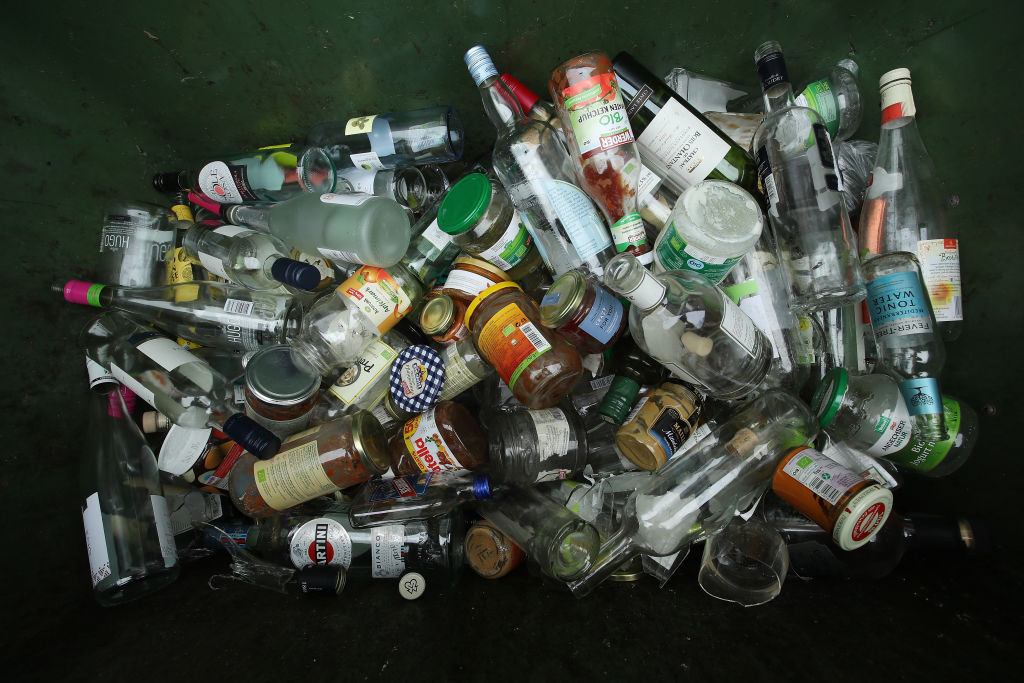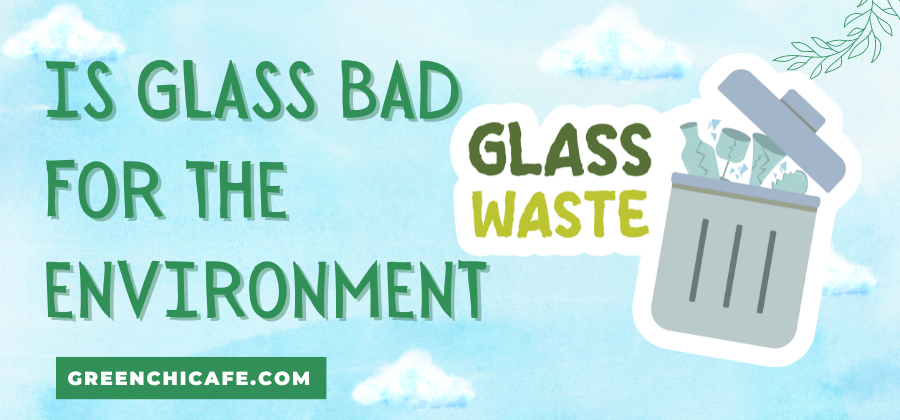Glass production and use have raised concerns about the material’s environmental impact.
With heightened awareness of sustainability, many wonder if the glass is truly an eco-friendly choice.
This article examines if the glass is bad for the environment.
Is Glass Bad for the Environment?

Given glass’s recyclability and durability compared to plastics, and the fact that recycled glass reduces energy use and emissions versus virgin production, glass is generally better for the environment than plastic alternatives when recycled and reused responsibly.
Proper recycling and reuse programs for glass provide environmental benefits and help reduce its footprint.
Key Points
- Glass production requires substantial energy inputs, often from fossil fuels that emit greenhouse gases. However, recycled glass reduces energy use by 3-13% compared to virgin production.
- Glass is infinitely recyclable back into new glass objects without any loss of purity or quality. Recycling glass avoids raw material extraction and saves up to 80% of energy use.
- Refillable glass bottles reused through deposit programs offer the clearest sustainability advantage compared to single-use plastic bottles or aluminum cans.
- While glass production emits more CO2 than plastic, plastics accumulate in ecosystems, leach chemicals, and their recycling is limited. Glass is chemically stable and inert.
- Lighter packaging has lower transport emissions, but plastics still have larger overall environmental impacts from their lifecycle issues.
What Raw Materials Are Used to Make Glass?
Glass production starts by heating a mix of materials to extremely high temperatures.
The main ingredients in glass are silicon dioxide (sand), sodium oxide (soda ash), and calcium oxide (limestone).
While abundant, sand mining disturbs landscapes and limestone quarrying harms biodiversity.
Soda ash comes from mineral deposits, contributing to their depletion.
Making glass thus consumes both energy and non-renewable resources – two negatives for the planet.
How Is Glass Made?
Glass manufacturing requires heating raw materials to over 2800°F to fuse them into a molten liquid.
This consumes substantial energy, often derived from fossil fuels that emit greenhouse gases.
Glass furnaces also emit air pollutants like nitrogen oxides, sulfur dioxide, and particulate matter.
Does Glass Production Generate Significant Waste?
Glass manufacturing yields small amounts of mineral waste.
But waste glass from households and businesses can be recycled repeatedly back into new glass.
Because glass is infinitely recyclable, and recycled glass reduces energy use by 3-13%, recycling mitigates the climate impact of virgin glass production.
With concerted recycling efforts, glass could be a circular economy success story.
Is Glass Packaging Better Than Plastic?
Comparisons between glass and plastic packaging show advantages and drawbacks to both.
Glass production emits more CO2 than plastic.
But plastics have other impacts.
Plastics leach chemicals into food and drinks.
They also break down into microplastics that permeate ecosystems.
While heavier to transport, glass is inert and won’t leach chemicals.
Glass containers are easily reused and recyclable while plastics are more limited in reuse and recycling.
For beverages, refillable glass bottles reused through deposit programs provide the clearest sustainability advantage over plastic bottles or cans.
Does Glass Breakdown Contribute to Pollution?
Glass is made of natural minerals and is chemically stable.
It will not decompose or leach chemicals.
However, broken glass littered into the environment does pose hazards for wildlife and humans.
Proper disposal, recycling, and waste management are key to preventing glass from becoming environmental pollution.
With concerted effort, glass waste in ecosystems can be avoided.
What Are the Benefits of Glass Recycling?
Glass recycling provides enormous environmental benefits.
It reduces the need for virgin raw materials and avoids glass waste.
Recycling glass into new containers or fiberglass insulation cuts air emissions, energy use, water consumption, and mining impacts by up to 80% compared to using raw materials.
With its infinite recyclability, glass that is properly recycled and reused has significant sustainability advantages.
It is a permanent material, not downcycled, able to be recycled endlessly without loss of purity or quality.
Is the Weight of Glass an Environmental Concern?
Glass is much heavier than plastic packaging, making it more energy intensive to transport.
Lighter packaging generally has lower associated emissions.
However, plastic packaging still ultimately has larger environmental impacts across its lifecycle due to disposal issues, recycling limitations, and plastic pollution.
Refillable glass bottles with local reuse offer the greenest option by reducing transport miles.
Are There Greener Alternatives to Glass?
Some eco-conscious consumers advocate using natural materials like wood, bamboo, or reusable metals over glass.
Upcycling and buying secondhand items also avoid the demand for new production.
But for containers needing strength, transparency, or impermeability, glass remains a good option – especially if recycled and reused.
No material choice is perfect.
Using less and recycling responsibly helps reduce glass’s footprint.
Can Glass Production Become Greener?
The glass industry can further reduce its environmental impact by maximizing recycled content, improving furnace efficiency, utilizing low-carbon energy sources, and developing new sustainable material mixes.
Recycling programs and greener manufacturing are keys to eco-friendlier glass.
Glass companies are working to lighten glass weight for packaging and incorporate more recycled glass.
Lighter glass reduces transportation emissions while increasing recycled content lowers energy used in manufacturing.
Why is recycling glass bad for the environment compared to plastic?
While glass recycling provides benefits over landfilling, some argue it has larger environmental impacts than plastic recycling.
Producing glass from recycled cullet still requires extensive heating, consuming substantial energy.
Glass is also heavy, causing higher emissions in transport to recycling facilities.
However, plastic recycling has its drawbacks.
Only some plastics are recyclable, many items are discarded due to contamination, and recycled plastic is lower grade.
Plastics also release toxins when improperly incinerated.
Ultimately plastic recycling rates are low, while glass recycling saves considerable energy and resources versus manufacturing from raw materials.
With proper systems in place, glass recycling remains an environmentally preferable option compared to plastic recycling or disposal.
How much energy can you save by recycling glass?
Recycling glass significantly reduces energy consumption compared to creating new glass from raw materials.
According to the Glass Packaging Institute, every ton of glass recycled saves the equivalent of nine gallons of fuel oil needed to make glass from virgin materials.
The energy saved provides enough electricity to power a computer for 25 days.
Overall, recycling glass into new containers saves up to 80% of the energy required to produce glass from sand, soda ash, and limestone.
Using cullet, or crushed recycled glass, in manufacturing also reduces furnace temperatures by hundreds of degrees.
The more glass is recycled, the greater the energy savings.
With optimal reuse and recycling, glass can play an integral role in sustainable resource use.
What are the environmental effects of glass production?
Producing glass from raw materials has a range of environmental impacts, including:
- Air emissions: Glass furnaces release nitrogen oxides, sulfur dioxide, particulate matter, and other pollutants into the air. However, regulations have reduced emissions over time.
- Solid waste: Small amounts of mineral waste are generated during glass production. This includes cullet bits and pieces as well as slag from furnaces.
- Resource extraction: Manufacturing glass requires mining silica sand, limestone, and soda ash, depleting these natural resources.
- Energy consumption: Glass furnaces are energy intensive, relying heavily on fossil fuels that emit greenhouse gases.
- Water use: Water is used for cooling equipment and in manufacturing processes like cleaning cullet.
However, the environmental effects of virgin glass production are mitigated by reusing and recycling waste glass back into the manufacturing process.
Overall, glass is considered an environmentally sound material when recycling and reuse are maximized.
Is glass infinite recyclable?
Yes, glass is infinitely recyclable back into new glass products without any loss in purity or quality.
This makes glass unique compared to other recyclable materials like plastic or paper.
When glass is recycled, it is crushed into a cullet and mixed with raw batch materials to create new glass items.
Cullet melts at lower temperatures, reducing energy consumption.
There is no limit to the number of times glass can be recycled using this process.
The infinite recyclability of glass makes it highly sustainable if recycled properly.
As an inert material, glass never wears out or becomes contaminated.
Recycling glass reduces the need for virgin raw materials and avoids sending glass to landfills.
With effective collection and processing, glass recycling can be maximized for environmental benefits.
The Bottom Line on Glass and the Environment
While no material use is without impact, glass is better for the environment than many disposable plastic alternatives when recycled and reused responsibly.
By reusing and recycling glass rather than discarding it, communities and companies can reduce glass’s footprint and harness its advantages as an enduring, non-toxic material.
With proper care, glass can play a meaningful role in sustainable, low-waste living.
FAQ
What are some pros of glass for the environment?
- Glass is infinitely recyclable without loss of purity or quality, avoiding raw material extraction. Recycled glass reduces energy consumption in manufacturing by 3-13%.
- Glass is non-porous and chemically stable so it does not leach chemicals into food or drinks. It will not decompose or break down into microplastics.
- Refillable glass bottles are easily reused many times through sterilization and cleaning. Reuse avoids waste generation.
- Glass is made of natural minerals and is inert in the environment. It will not decompose or release toxins if littered.
What are some cons of glass for the environment?
- Glass furnace operations consume substantial energy and release air pollutants including greenhouse gases. However, some plants are transitioning to renewable energy.
- Producing glass from raw materials requires mining silica sand and limestone, depleting these resources and disturbing landscapes. Recycling avoids virgin extraction.
- Broken glass littered into ecosystems can injure wildlife and humans. Proper disposal and waste management prevent the glass from becoming polluted.
- Glass packaging is heavier than plastic, resulting in higher emissions from transportation. However, plastic has larger lifecycle impacts.
How does glass compare to plastics environmentally?
- Plastics accumulate in landfills and ecosystems because they do not biodegrade. They also leach hazardous chemicals into the contents. Glass is stable and inert.
- Plastics break down into microplastics that are ingested by organisms and accumulate up the food chain. Glass does not decompose into microparticles.
- Glass is infinitely recyclable into new glass without quality loss. Only some plastics are recyclable, and they degrade with repeated recycling.
- The weight of glass makes it more energy intensive to transport than lightweight plastics. But plastic has other detrimental impacts including pollution and toxicity issues.
At GreenChiCafe, we are passionate about the environment and our natural world. Please check out our website for more content on living sustainably and reducing our environmental footprint.

Annie is a passionate environmental writer and activist. She has been writing about sustainability, conservation, and green living for over 15+ years. Annie is dedicated to raising awareness about environmental issues and providing practical tips for living an eco-friendly lifestyle. When she’s not writing, you can find her volunteering with local environmental organizations, teaching workshops on zero waste living, or exploring nature. Feel free to get in touch with Annie: annie@greenchicafe.com

